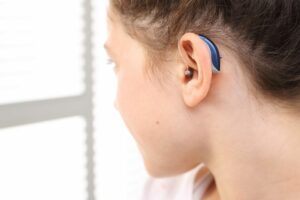
In recent years, the hearing aid industry has undergone a remarkable transformation. With more young people at risk of hearing loss, the demand for hearing aids has surged, leading to a proliferation of new options, including over-the-counter hearing aids. This article will explore the changing landscape of hearing aids and the evolving needs of their users, particularly among the younger generation. We will delve into the reasons behind this shift, the challenges users face, and the impact of technology on hearing aid adoption. Furthermore, we will discuss the role of over-the-counter hearing aids and the factors driving their popularity. Let’s dive into this exciting topic!
The Rising Demand For Hearing Aids Among Young Adults
Experts have noticed a significant rise in the number of young adults who either need or use hearing aids. While pinpointing the exact figures is challenging, Phonak, a leading prescription aid manufacturer, reported a remarkable 14 percent increase in Americans aged 22 to 54 fitted with their hearing aids between 2017 and 2021. This trend indicates that younger demographics are facing hearing issues earlier in life, a phenomenon that was less prevalent in previous generations.
Shifting Attitudes and Evolving Technology
One reason behind the increased acceptance of hearing aids among young adults is the advancement of technology. As hearing aid technology improves, these devices become more sophisticated, smaller, and less conspicuous. This development has led to a change in attitudes, with more young people now willing to try hearing aids to improve their hearing experience.
The Noise-Soaked World of the Young Generation
Today’s young adults navigate an environment filled with noise pollution from various sources like loud music, bustling urban streets, and the constant use of earphones. The World Health Organization estimates that more than a billion young individuals worldwide are at risk of noise-induced hearing loss due to these factors. The awareness of these risks has pushed more young people to consider hearing aids as a preventive measure and a way to manage existing hearing issues.
Barriers to Entry: Cost and Complexity
While the demand for hearing aids among young adults is rising, there are significant barriers that prevent some from obtaining these devices. Hearing aids can be expensive, with most models costing over $1,000. This high cost poses challenges, especially for young adults without good medical insurance coverage. Additionally, the plethora of options can be overwhelming, making it difficult for potential users to choose the most suitable device for their needs. Furthermore, many hearing aid models still require a prescription from an audiologist, adding another layer of complexity to the process.
Eroding Stigma Around Hearing Aids
Historically, wearing hearing aids carried a stigma that impacted users’ self-esteem and confidence. However, attitudes towards hearing aids have shifted over the years. According to a report from MarkeTrak, a consumer research organization, modern hearing aid users rarely feel embarrassed or rejected due to their devices. The decline in stigma has contributed to increased acceptance and adoption among young adults.
The Emergence of Over-the-Counter Hearing Aids
One significant development in the hearing aid market is the emergence of over-the-counter (OTC) hearing aids. These devices offer an alternative to traditional prescription aids, providing consumers with greater freedom and choice. OTC hearing aids are available without a prescription and can be purchased directly from retailers or online platforms. The convenience of OTC options has enticed many users, especially those seeking cost-effective and accessible solutions.
Diverse Options for Every User
The rise of OTC hearing aids has introduced a wide array of options to consumers. From discreet in-ear pods to stylish metallic arcs that wrap around the ear, individuals can choose a design that suits their preferences and lifestyle. Moreover, most new hearing aid models come equipped with Bluetooth streaming capabilities, enabling seamless connectivity with smartphones and other devices.
Conclusion
As the landscape of hearing aids evolves, their users are undergoing a transformation too. Young adults are increasingly embracing hearing aids, acknowledging the potential benefits in a world filled with noise-related challenges. Technological advancements have contributed to shifting attitudes, making hearing aids more acceptable and appealing to this demographic. However, significant barriers remain, such as high costs and the complexity of the options. The emergence of over-the-counter hearing aids offers a promising solution for those seeking accessibility and affordability. With the stigma fading away, more young adults are embracing hearing aids as essential devices that enhance their quality of life.
FAQs
Do over-the-counter hearing aids require a prescription?
No, over-the-counter hearing aids can be purchased without a prescription, making them more accessible to users.
What is the average cost of hearing aids?
Most hearing aids cost over $1,000, with some high-end models exceeding this price range.
Are modern hearing aids discreet and comfortable to wear?
Yes, advancements in technology have made hearing aids smaller and more comfortable, reducing their visibility and enhancing user comfort.
Do hearing aids come with Bluetooth capabilities?
Yes, many new hearing aid models feature Bluetooth streaming, allowing users to connect with smartphones and other devices wirelessly.
Can I order over-the-counter hearing aids online?
Yes, some over-the-counter hearing aids are available for purchase online with free shipping options.


